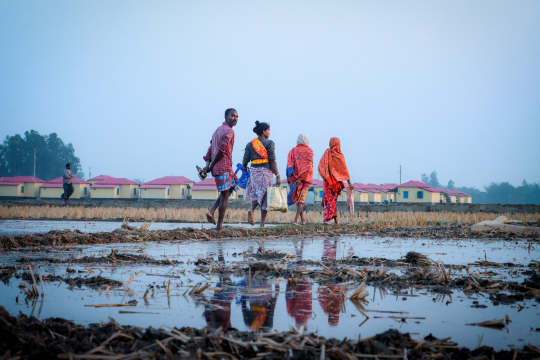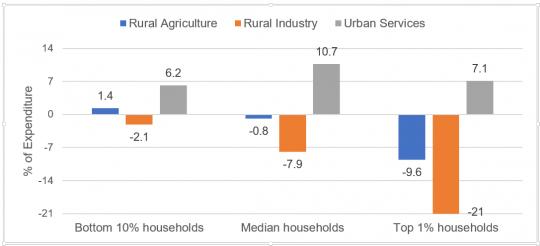Over the last three decades, agricultural and industrial sector workers have suffered consumption losses due to temperature rise while those in the services sector saw consumption increases. This article discusses the broad range of impacts of climate change across sectors and highlights the stark rise in inequality of household consumption due to increased temperature variability. It emphasises the need for social protection schemes, and data on the economic impacts of climate change to aid the design of adaptation policies.
Since the late 1980s, temperatures have risen by over 1°C in several parts of India due to anthropogenic climate change. The gradual rise in temperature has negatively affected economic activity and caused income losses, while also reducing crop yields and worker productivity. Although economic damages anticipated over the coming decades remain uncertain, the temperature rise has been adversely affecting household incomes since the 1980s in disparate ways across economic sectors.
In a recent study (Aggarwal 2021), I analysed the impacts of climate change-induced temperature variability, or ‘climate shocks1, on household monthly per capita consumption expenditure (MPCE)2 across India, from 1987 to 2012. The findings revealed divergent impacts of climate shocks across households in the agricultural, industrial, and service sectors.
The agricultural sector is considered the most vulnerable to climate change, primarily due to its dependence on the monsoon and need for predictable weather conditions. Fluctuations in temperature and rainfall patterns thus reduce crop yields and lead to losses in output (Government of India, 2018). Large-scale reductions in agricultural production can pose a threat to national food security, and in the short-term, lead to food price inflation.
The industrial sector is also impacted by higher and more variable temperatures through multiple channels. First, factory workers suffer physiological heat stress that lowers their productivity – in the absence of cooling through fans or ACs, this can also cause fatigue and other health conditions (Somanathan et al. 2021).
Since most workers are daily wage earners, having fewer effective work hours reduces their wages and thus, household consumption expenditure. While this effect occurs for agricultural workers, particularly landless labourers, I find that it is especially prominent in the industrial sector. High temperatures also diminish the efficiency of the firm’s capital stock (that is, machinery and equipment), and leads to a contraction in total firm output, impacting the incomes of business owners.
Individuals employed in the services sector similarly exhibit heat stress due to higher temperatures. However, the crucial difference is the ready use of cooling systems like ACs or fans in office buildings, commercial outlets and even small retail shops, which limits the adverse effects of heat stress.
As my study finds, the consequent rise in energy demand in fact, leads to increases in the monthly household consumption expenditure of these households, albeit without an increase in household incomes. Richer households thus better cope with negative effects by investing in cooling systems and raising their energy consumption through their household savings.
How climate shocks contribute to rising inequality
In my study, I combine economic data at the district-level from the NSSO’s Consumer Expenditure Surveys with monthly climate data on temperature and precipitation for the corresponding districts from the University of East Anglia’s Climatic Research Unit, to analyse the causal impact of the exogenous variation in temperature from long-run district-wise averages on monthly consumption expenditure at the household level. I find that while farmers and industrial workers residing in rural areas experienced consumption declines on average, individuals employed in the services sector, irrespective of the region, observed increases in monthly consumption expenditure.
Climate shocks further have important distributional consequences. The study finds that rural industrial workers across the national income distribution are adversely affected by climate shocks and experience consumption losses in the vast range of 2-21% (Figure 1). At the median, the consumption loss is 8% of monthly household expenditure. Urban households of the services sector, however, unambiguously witness increases in consumption of 6-11%, across the income distribution. Thus, climate shocks contribute to increasing inequality both within and across economic sectors.
Without data on household incomes, it cannot be ascertained whether the increase in consumption expenditure for the services sector is due to a rise in household income (and thus consumption levels), or a decline in savings (possibly being used to smooth consumption). However, a decline in MPCE for agricultural and industrial sector households due to climate shocks, regardless of changes in savings/assets, certainly reflects a fall in the standard of living for these households. The broad range of impacts across sectors therefore highlights a stark rise in inequality of household consumption due to increased temperature variability.
Within the agricultural income distribution, several farming households are net sellers of food in produce markets. In the face of a sudden food price increase, farmers that are net suppliers may experience a temporary increase in incomes, even though the aggregate food supply has been reduced due to the weather shock.
This may lead to a temporary rise in consumption expenditure, without a real increase in farmers’ living standards. While the consumption survey data do not allow us to ascertain the net supply position of farmers, we do observe modest consumption increases among the bottom 10% of rural farming households, which suggests these households may be net food suppliers to the agricultural market (see Figure 1).
At the upper end of the distribution, we observe consumption declines of 1-10% among rural agricultural households. We posit that richer agricultural households who own large tracts of land may experience declines in land values due to reduced crop yields from temperature fluctuations, which may negatively affect their household consumption expenditures.
The role of social protection
Given multiple adverse effects of high temperatures observed on approximately 70% of India’s population over the last three decades, provision of social protection in the form of government schemes is essential to combat the negative impacts of climate change. These could include cash transfers for income support (for instance, to purchase cooling equipment in the event of high temperatures) and increases in the allocation of food subsidies through the Targeted Public Distribution System, particularly for agricultural and industrial sector workers. An expansion in access to MGNREGA, especially in the event of crop losses due to weather anomalies (Taraz 2023), would further provide employment opportunities and ameliorate declines in consumption.
At a broader level, the rise in consumption inequality due to climate change can be alleviated through compensation schemes targeted at mitigating the effects of heat stress by supporting and subsidising the purchase of cooling equipment and food, particularly for poorer households in rural areas. The government’s National Adaptation Fund for Climate Change targets a few states that are highly vulnerable to climate change, but funding is limited to specific projects. Yet, temperature increases have affected millions of households across the country for close to three decades and its effects are likely to worsen in the future, creating the need for additional funding allocation toward mitigation, adaptation and redistribution measures.
Conclusion
While the study captures climatic impacts on household consumption levels, the lack of nationally representative survey data on household incomes and savings for the recent decade precludes further sectoral analysis. Nonetheless, consumption expenditure is an important metric to assess standards of living and indeed the benchmark to measure poverty levels in India. Timely and updated household survey data on consumption expenditure are therefore essential to gauge the economic impacts of climate change on households across the country. The evidence generated would aid the design of critical adaptation, compensation and mitigation policies to prevent declines in household consumption and counter the rise in inequality.
This post was originally published at Ideas for India and can be accessed here. Published with permission.
The author would like to thank Utkarsh Patel for valuable comments on the post. She also thanks Deepak Kumar, Bhanu Pratap, Aarti Malik and Daattavya Aggarwal for helpful suggestions.
Notes:
- Climate shock is defined as a one standard deviation increase in temperature above the historical district-level average value. Thus, climate shocks across different geographical regions in India are comparable.
- MPCE is a measure of households’ standard of living and comprises consumption expenditure incurred on a range of non-durable and durable items including food, energy, transport, clothing, and others. MPCE is calculated as the household’s total monthly consumption expenditure divided by the number of household members.
Further Reading
- Aggarwal, Raavi (2021), “Impacts of climate shocks on household consumption and inequality in India”, Environment and Development Economics, 26(5-6: Weather and Climate Impacts in Developing Countries): 488-511.
- Government of India (2018), ‘Climate, climate change and agriculture’, in Economic Survey of India, 2017-18, Vol. 1.
- Somanathan, E., Rohini Somanathan, Anant Sudarshan and Meenu Tewari (2021), “The Impact of Temperature of Productivity and Labor Supply: Evidence from Indian Manufacturing”, Journal of Political Economy, 129(6).
- Taraz, Vis (2023), “Public works programs and agricultural risk: Evidence from India”, The Australian Journal of Agricultural and Resource Economics, 67(2): 198-223

